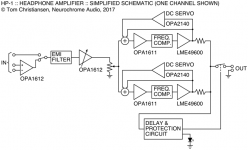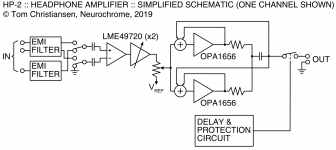World, I present to you the All-DIY Neurochrome HP-2 ultra-low distortion headphone amp.
I will be demoing it tomorrow (Sunday Nov. 10, 2019) at the Burning Amp Fest at Ft. Mason. If you're in San Francisco, please stop by for a demo and chat.
Key features of the HP-2:
Build budget:
Spec. highlights:
You can find the circuit description and full specifications on my website: Neurochrome HP-2.
But, but... What does it sound like? I like it, obviously. Ever since I heard my first precision amp, I've been hooked on the precise (i.e. ultra-low distortion) sound. I prefer that the amp makes as little contribution to the sound as possible, as I believe this allows for experiencing the music the way the artist and recording engineers intended it. The precision of the HP-2 allows it to provide realistic and natural rendition of the source material, with a wide and open sound stage (even in headphones!).
The HP-2 will only be available as a DIY product, i.e. I will not be offering it in a fully assembled option. The PCB features two surface mounted components. They're relatively easy to solder 8-pin SOICs. Should you wish to have me solder those ICs for you, I can do that for a small fee.
In addition to the PCB, I offer a nice aluminum chassis, which has been custom designed for the HP-2. The chassis is a very nice option for DIYers who would like to showcase their builds in the form of a professional-looking product.
I am offering the HP-2 at pre-order prices until they arrive in stock or until the first ten HP-2s have sold (whichever occurs first). You can buy your HP-2 here: Neurochrome HP-2.
Thanks,
Tom
I will be demoing it tomorrow (Sunday Nov. 10, 2019) at the Burning Amp Fest at Ft. Mason. If you're in San Francisco, please stop by for a demo and chat.
Key features of the HP-2:
- 4-layer PCB fully optimized for performance while being relatively easy to assemble.
- Output power: 440 mW (32 Ω), 660 mW (50 Ω), 260 mW (300 Ω) at vanishingly low distortion.
- Inputs: Balanced/differential (XLR) and unbalanced/single-ended (RCA).
- Alps "Blue Velvet" volume potentiometer.
- +5 dB and +15 dB gain settings (jumper selectable).
- Integrated headphone protection circuit, which disconnects your headphones in the case of DC voltage on the output of the amplifier.
- Integrated output muting circuit ensures that the HP-2 is completely absent of turn-on and turn-off clicks and pops.
- Optimized on-board RLC power supply filter allowing for stellar performance with the recommended switching power supply.
- External 28 VDC switching power supply accepting 85 – 264 VAC mains for use world wide.
- The PCB features elaborate use of planes and copper pours to maximize circuit performance by minimizing supply and ground impedances.
- On-board EMI/RFI input filter to prevent wifi and switch transients from interfering with the sound reproduction.
- With the exception of two SOIC-08 surface mounted ICs, the HP-2 is all through-hole construction with socketed ICs and is easy to solder.
- Bill-of-materials includes a Mouser Electronics Project Link for ease of parts ordering.
- Gold plated PCB, fully electrically tested by the manufacturer.
- PCB is designed and manufactured in Canada.
- Custom designed chassis manufactured in Italy.
Build budget:
- Cost of parts for the PCB: ~$160 (including power supply)
- Cost of a full build using my custom chassis: ~$500
Spec. highlights:
- Output power: 440 mW (32 Ω); 660 mW (50 Ω); 260 mW (300 Ω)
- THD: < -130 dBc (50 mW, 300 Ω)
- Multi-tone IMD residual: -144 dBr (AP 32-tone, ref. 100 mW, 300 Ω)
- Output noise: 1.0 µV RMS (A-wt, 20 Hz - 20 kHz)
- Dynamic range: 125 dB
- Gain: +5 dB, +15 dB (jumper selectable)
- Input sensitivity: 2.90 V, 865 mW (gains +5 dB, +15 dB, respectively; 100 mW, 300 Ω)
You can find the circuit description and full specifications on my website: Neurochrome HP-2.
But, but... What does it sound like? I like it, obviously. Ever since I heard my first precision amp, I've been hooked on the precise (i.e. ultra-low distortion) sound. I prefer that the amp makes as little contribution to the sound as possible, as I believe this allows for experiencing the music the way the artist and recording engineers intended it. The precision of the HP-2 allows it to provide realistic and natural rendition of the source material, with a wide and open sound stage (even in headphones!).
The HP-2 will only be available as a DIY product, i.e. I will not be offering it in a fully assembled option. The PCB features two surface mounted components. They're relatively easy to solder 8-pin SOICs. Should you wish to have me solder those ICs for you, I can do that for a small fee.
In addition to the PCB, I offer a nice aluminum chassis, which has been custom designed for the HP-2. The chassis is a very nice option for DIYers who would like to showcase their builds in the form of a professional-looking product.
I am offering the HP-2 at pre-order prices until they arrive in stock or until the first ten HP-2s have sold (whichever occurs first). You can buy your HP-2 here: Neurochrome HP-2.
Thanks,
Tom
Attachments
-
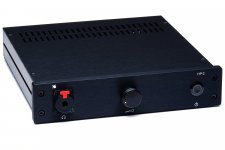 HP-2_Front.jpg206.8 KB · Views: 1,744
HP-2_Front.jpg206.8 KB · Views: 1,744 -
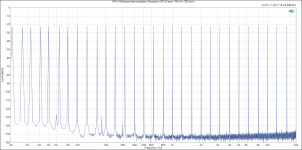 HP-2_ Multitone Intermodulation Distortion (AP 32-tone, 100 mW, 300 ohm).PNG95.8 KB · Views: 429
HP-2_ Multitone Intermodulation Distortion (AP 32-tone, 100 mW, 300 ohm).PNG95.8 KB · Views: 429 -
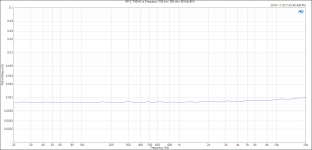 HP-2_ THD+N vs Frequency (100 mW, 300 ohm, 60 kHz BW).PNG46.1 KB · Views: 435
HP-2_ THD+N vs Frequency (100 mW, 300 ohm, 60 kHz BW).PNG46.1 KB · Views: 435 -
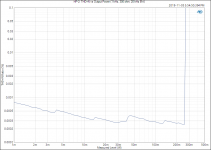 HP-2_ THD+N vs Output Power (1 kHz, 300 ohm, 20 kHz BW).png39.1 KB · Views: 547
HP-2_ THD+N vs Output Power (1 kHz, 300 ohm, 20 kHz BW).png39.1 KB · Views: 547 -
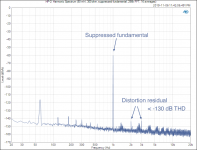 HP-2_ Harmonic Spectrum (50 mW, 300 ohm, suppressed fundamental, 256k FFT, 16 averages) - annota.png52.2 KB · Views: 1,746
HP-2_ Harmonic Spectrum (50 mW, 300 ohm, suppressed fundamental, 256k FFT, 16 averages) - annota.png52.2 KB · Views: 1,746 -
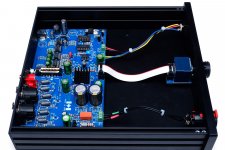 HP-2_Inside.jpg415.2 KB · Views: 1,738
HP-2_Inside.jpg415.2 KB · Views: 1,738 -
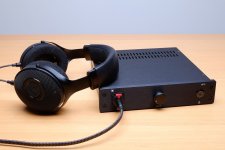 HP-2_wFocal.jpg304.9 KB · Views: 1,734
HP-2_wFocal.jpg304.9 KB · Views: 1,734 -
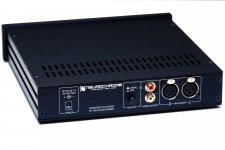 HP-2_Rear.jpg261.5 KB · Views: 1,721
HP-2_Rear.jpg261.5 KB · Views: 1,721
Last edited:
Measures better than a "The Wire BAL-BAL", but given the transparency of the BAL-BAL already I doubt I would ever notice a difference with existing direct coupled HD800.
One area I would suggest in the next version is a true differential output, many who would spend that much for a HP amp would already have an existing 4 pin rig.
One area I would suggest in the next version is a true differential output, many who would spend that much for a HP amp would already have an existing 4 pin rig.
You can build the HP-2 with the following outputs:
There's only a minuscule benefit of using the 4-pin connector. You get ever so slightly better channel separation as you do not have the shared ground connection in the 4-pin connector.
Some will argue that a balanced amp will provide lower distortion due to the cancellation of harmonics. That's true in a high-distortion design. The cancellation doesn't work well for low-distortion amplifiers. In fact, any sort of cancellation scheme is much more likely to degrade the performance of a low-distortion amp than to improve it. Even in the cases where the THD is reduced by such cancellation, the cancellation mostly affects the even order harmonics – the ones most find pleasant sounding – while leaving the odd order harmonics (that many find to sound harsh) in place.
Tom
- 1/4" phone connector
- 3.5 mm phone connector
- 4-pin XLR connector
There's only a minuscule benefit of using the 4-pin connector. You get ever so slightly better channel separation as you do not have the shared ground connection in the 4-pin connector.
Some will argue that a balanced amp will provide lower distortion due to the cancellation of harmonics. That's true in a high-distortion design. The cancellation doesn't work well for low-distortion amplifiers. In fact, any sort of cancellation scheme is much more likely to degrade the performance of a low-distortion amp than to improve it. Even in the cases where the THD is reduced by such cancellation, the cancellation mostly affects the even order harmonics – the ones most find pleasant sounding – while leaving the odd order harmonics (that many find to sound harsh) in place.
Tom
No block diagram (yet) on your site, like the HP1 .
HP-2 – Neurochrome
How do you go from the 28Vdc to a + and - supply ?
It's LME49720 + 2 paralleled OPA1656 with an AC coupled output, so a capacitor at the output . mmm...
Output Impedance 2.6 Ω ? Pretty high...
HP-2 – Neurochrome
How do you go from the 28Vdc to a + and - supply ?
It's LME49720 + 2 paralleled OPA1656 with an AC coupled output, so a capacitor at the output . mmm...
Output Impedance 2.6 Ω ? Pretty high...
Attachments
No block diagram (yet) on your site, like the HP1 .
Correct. I need to proofread about half the verbiage as well. 24 hours/day one person kinda thing. I just got caught up after returning from BAF.
How do you go from the 28Vdc to a + and - supply ?
I don't. Hence, the output cap. I use nested feedback to eliminate the THD of the output cap. It works rather well.
Output Impedance 2.6 Ω ? Pretty high...
Meh... Does it matter? I agree that it won't look as good on Amir's ranking plots on Audio Science Review, but it will certainly work well (as my data show).
Tom
The PCBs are on the UPS truck from the manufacturer in Ontario, Canada and should arrive tomorrow. The parts from my test order with Mouser arrived today, so once I have the PCBs, I will build one to verify the layout and BOM. If that checks out (which I certainly hope as I ordered 200 boards!) I will ship the PCBs starting Monday. I expect to have the documentation ready by then as well.
The chassis should ship from Italy within the next few days here. They ship by FedEx, so they should get here pretty quickly.
I apologize for the delay. That's in part why I offered the first ten boards at a 10% discount. The discount is basically my "thank you" for your patience.
Tom
The chassis should ship from Italy within the next few days here. They ship by FedEx, so they should get here pretty quickly.
I apologize for the delay. That's in part why I offered the first ten boards at a 10% discount. The discount is basically my "thank you" for your patience.
Tom
Yes Brian; I can read as well as you. And I don't know why you have to add your six penny's worth when my question was to Tom who I have bought perhaps a dozen boards from over several years.
Tom; when you wrote "I will be demoing it tomorrow (Sunday Nov. 10, 2019) at the Burning Amp Fest at Ft. Mason." I didn't imagine that you had only one board.
And on 21st Nov you wrote "I have one PCB left at the intro price." Not that you had the order space for one last PCB.
I'm just saying that some more clarity and an update woulda been nice. In the past your communication, over multiple orders, has been exemplary.
Just sayin'.
tim
Tom; when you wrote "I will be demoing it tomorrow (Sunday Nov. 10, 2019) at the Burning Amp Fest at Ft. Mason." I didn't imagine that you had only one board.
And on 21st Nov you wrote "I have one PCB left at the intro price." Not that you had the order space for one last PCB.
I'm just saying that some more clarity and an update woulda been nice. In the past your communication, over multiple orders, has been exemplary.
Just sayin'.
tim
I think you'd be surprised by how many don't read the information on my website (or email for that matter). I just received an email asking about the price and availability of my upcoming Universal Buffer, even though my website says $125 and mid January (both subject to change). I'm certainly open to suggestions for how to improve my communication.
Yes. I only had one board. I brought the prototype build to BAF and needed to make a couple of small circuit tweaks between it and the final revision. Unfortunately, the circuit tweak that I needed to make rendered the remaining 3-4 boards in the prototype board run unsellable - or at least not up to my quality standards. I refuse to sell rejects. My customers (rightfully) expect and deserve better.
If I had a small stack of good boards tucked away somewhere, I would have shipped them.
My website has consistently said "Out of stock, but available on backorder. More is expected to arrived by ..." In Post #1, I said, "I am offering the HP-2 at pre-order prices until they arrive in stock or until the first ten HP-2s have sold (whichever occurs first)." Similarly, my November newsletter stated, "Now available on preorder. 10 % discount for the first 10 early adopters!" at the very top. I thought those statements were pretty clear and unambiguous.
Yeah... I suppose you can split the hair that way. This is the first time I hear the term "order space", so that interpretation hadn't occurred to me until now. Maybe I should just not have preorder sales. That would solve this problem nicely.
The purpose of the preorders is to generate a little excitement or 'buzz' up front, and to help put a dent in the rather large up-front investment I make when I launch a new project. If the end result is disappointed customers, it sounds like it would be better to just get rid of the preorders altogether - or at least get rid of the sale part.
Thank you for your feedback. I appreciate it. You're right. I could certainly have sent out more updates via email to those who preordered. I could possibly also have better communicated that the HP-2 was on preorder by adding "PREORDER" to the product title, though that term seems to confuse some people. As does the term "backorder", by the way.
I work about 12-14 hours/day 6-7 days/week to launch two Neurochrome products and nudge the production of the TCA HPA-1 through production (and plan upcoming products). Email seems to be the first to fall through the cracks. Sorry about that. I also tend to lose track of what I've said via email, newsletter, Facebook, DIY Audio, etc.
Anyway: UPS says the boards have arrived in town. I expect them to arrive on my doorstep this afternoon. This should NOT be interpreted as a guarantee that this will happen, only that I expect this to happen. IF the boards arrive this afternoon, I expect to ship on Monday. I do need to complete my prototype build before I ship the boards, though. I expect to be able to do that this weekend.
Tom
Tom; when you wrote "I will be demoing it tomorrow (Sunday Nov. 10, 2019) at the Burning Amp Fest at Ft. Mason." I didn't imagine that you had only one board.
Yes. I only had one board. I brought the prototype build to BAF and needed to make a couple of small circuit tweaks between it and the final revision. Unfortunately, the circuit tweak that I needed to make rendered the remaining 3-4 boards in the prototype board run unsellable - or at least not up to my quality standards. I refuse to sell rejects. My customers (rightfully) expect and deserve better.
If I had a small stack of good boards tucked away somewhere, I would have shipped them.
My website has consistently said "Out of stock, but available on backorder. More is expected to arrived by ..." In Post #1, I said, "I am offering the HP-2 at pre-order prices until they arrive in stock or until the first ten HP-2s have sold (whichever occurs first)." Similarly, my November newsletter stated, "Now available on preorder. 10 % discount for the first 10 early adopters!" at the very top. I thought those statements were pretty clear and unambiguous.
And on 21st Nov you wrote "I have one PCB left at the intro price." Not that you had the order space for one last PCB.
Yeah... I suppose you can split the hair that way. This is the first time I hear the term "order space", so that interpretation hadn't occurred to me until now. Maybe I should just not have preorder sales. That would solve this problem nicely.
The purpose of the preorders is to generate a little excitement or 'buzz' up front, and to help put a dent in the rather large up-front investment I make when I launch a new project. If the end result is disappointed customers, it sounds like it would be better to just get rid of the preorders altogether - or at least get rid of the sale part.
I'm just saying that some more clarity and an update woulda been nice. In the past your communication, over multiple orders, has been exemplary.
Thank you for your feedback. I appreciate it. You're right. I could certainly have sent out more updates via email to those who preordered. I could possibly also have better communicated that the HP-2 was on preorder by adding "PREORDER" to the product title, though that term seems to confuse some people. As does the term "backorder", by the way.
I work about 12-14 hours/day 6-7 days/week to launch two Neurochrome products and nudge the production of the TCA HPA-1 through production (and plan upcoming products). Email seems to be the first to fall through the cracks. Sorry about that. I also tend to lose track of what I've said via email, newsletter, Facebook, DIY Audio, etc.
Anyway: UPS says the boards have arrived in town. I expect them to arrive on my doorstep this afternoon. This should NOT be interpreted as a guarantee that this will happen, only that I expect this to happen. IF the boards arrive this afternoon, I expect to ship on Monday. I do need to complete my prototype build before I ship the boards, though. I expect to be able to do that this weekend.
Tom
UPS failed to meet my expectations as they have yet to deliver the PCBs. Local time is now 21:16, so I find it exceptionally doubtful that they will deliver today. Thus, they will arrive on Monday, which pushes my ship date out to Tuesday at the very earliest and most likely Wednesday.
I apologize for the delay, but I have no control over UPS's delivery schedule. The tracking states they were hit by weather yesterday (Toronto has had its first major snow fall recently) and I'm sure the holiday package traffic doesn't help much either.
Tom
I apologize for the delay, but I have no control over UPS's delivery schedule. The tracking states they were hit by weather yesterday (Toronto has had its first major snow fall recently) and I'm sure the holiday package traffic doesn't help much either.
Tom
Supply Voltage
Power supply can range from 18 to 30 V DC. Higher supply voltage results in more power. The default value is 28V.
Does increasing the supply voltage beyond 28V degrade the sound?
Changing the gain of the amp will change the performance of the amp. Can the same be said for changing the power supply voltage?
Power supply can range from 18 to 30 V DC. Higher supply voltage results in more power. The default value is 28V.
Does increasing the supply voltage beyond 28V degrade the sound?
Changing the gain of the amp will change the performance of the amp. Can the same be said for changing the power supply voltage?
- Home
- Vendor's Bazaar
- Neurochrome HP-2 ultra-low distortion headphone amplifier
